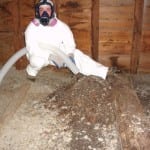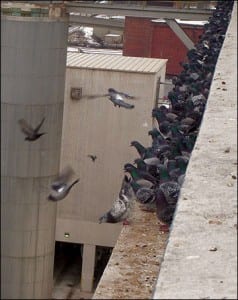|
Histoplasmosis is a disease caused by a fungus, which grows in pigeon droppings. It also grows in soils and is found throughout the world. When cleaning droppings a person may breathe in some of the fungus, which in cases of high exposure can cause infection. Common activities, such as cleaning off windowsills, will not result in high exposures. Symptoms of histoplasmosis begin to appear about 10 days after initial infection and include fatigue, fever, and chest pains. Most people, however, do not show any symptoms. Those with compromised immune systems such as cancer patients or people living with HIV/AIDS are generally more at risk of developing histoplasmosis. The disease cannot be transmitted from person to person. Cryptococcosis Cryptococcosis is another fungal disease associated with pigeon droppings and also grows in soils throughout the world. It is very unlikely that healthy people will become infected even at high levels of exposure. A major risk factor for infection is a compromised immune system. According to the US Centers for Disease Control (CDC), nearly 85 percent of cryptococcosis patients are HIV-positive. Psittacosis Psittacosis (also known as ornithosis or parrot fever) is a rare infectious disease that mainly affects parrots and parrot-like birds such as cockatiels, and parakeets, but may also affect other birds, such as pigeons. When bird droppings dry and become airborne people may inhale them and get sick. In humans, this bacterial disease is characterized by: fatigue, fever, headache, rash, chills, and sometimes pneumonia. Symptoms develop about 10 days after exposure. Psittacosis can be treated with a common antibiotic. Since 1996, fewer than 50 confirmed cases were reported in the United States annually. In New York City, psittacosis is very rare with less than one human case identified each year. According to the CDC, about 70% of infected people had contact with infected pet birds. Those at greatest risk include bird owners, pet shop employees, veterinarians, and people with compromised immune systems. No person-to-person cases have ever been reported.
Amount of waste that the average pigeon produces each year: 25 pounds !! Source: New Yorker,2007 Estimate of the number of pigeons in New York City: 1,000,000 !! Source: New York Daily, 2007 Amount the average pigeon produces annually in droppings: 25 lbs. Source: New Yorker,2007 |
|


 Histoplasmosis
Histoplasmosis
